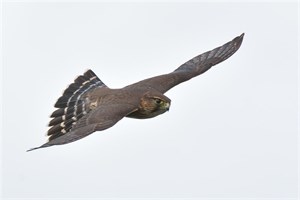Autumn 2018 Migration Wrap-Up
Posted on January 04, 2019 in Science

Autumn 2018 was full of rained-out, foggy, and chilly days on the Mountain. Despite the less-than-desirable weather, bald eagles, sharp-shinned hawks, Cooper's hawks, red-shouldered hawks, golden eagles, American kestrels, and merlins all had counts above their 10-year average, and bald eagles and merlins has new season count records.
The first official bird of this year's count was a sharp-shinned hawk, and the last official bird was an adult Cooper's hawk on December 13th. It was a slow end to the wet count season that still had many highlights, including the two new records and top-5 count days for several species. New season long count records were recorded for bald eagles with 546 and merlin with 247. A high count of 39 bald eagles on October 17th was the second highest single day count, 36 bald eagles on October 12th was the third highest count, 25 golden eagles on October 21st was the third highest count, and 27 merlins on October 13th was the fifth highest count in Hawk Mountain history. Only four species had counts below their 10-year average: black vultures, osprey, northern goshawks, and red-tailed hawks.
It's encouraging to see counts for so many species above their 10-year average, particularly American kestrels and sharp-shinned hawks, which have shown long-term and short-term population declines at Hawk Mountain. For late migrating species, such as the northern goshawk and red-tailed hawk, lack of snow cover to the north may have allowed them to remain on territory, and they will hopefully migrate through later in the season. However, counts of osprey continued their multi-decade decline. While yearly variation in count numbers are an interesting topic for conversation, population increases or decreases are best studied though long-term monitoring like that conducted at North Lookout. Please join us on the Lookout next year to see if the trends continue.